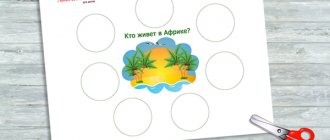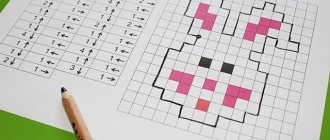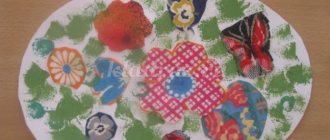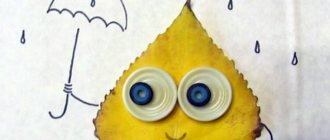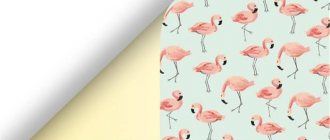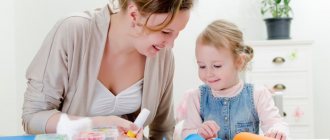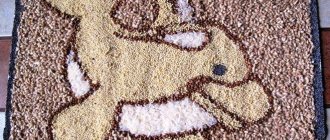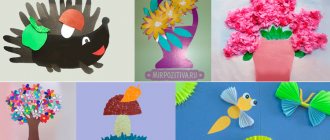How to make a paper train step by step with your own hands: practical application
A paper train is a fragile thing, unstable to deformation, and it is almost impossible to adapt it to active games. But such a thing also has practical applications in the nursery. For example, a photo train, in the form of a train carrying photographs of a baby. This could be a composition with photographs from the first month of life to a year, or simply favorite and touching family photos. Such a paper craft will not only be appropriate, but also useful in the nursery - bright colors and voluminous details are very useful for the development of the baby.
To make such a train yourself, you will not need any special skills or tools. All you need for work is: a stationery knife, a glue stick and scissors. In order to hang the train on the wall, you will additionally need a suitable braid or thick thread, two paper clips and two buttons that can be driven into the wall.
Templates are printed on a color printer, the inner windows are cut out with a stationery knife. A little advice - it’s better to print not on office paper, but on drawing paper. It works well with the printer, but is denser and is not so deformed by the glue.
On the reverse side, photographs are glued into a frame. If you wish, you can further decorate the train - for example, stick buttons on top of the wheels, or add printed cute details to the photographs themselves - animals, stars, flowers - depending on the gender of the child and your imagination.
To hang the composition on the wall, you must first assemble it on a thread. On the back side of each car, glue a thread along the entire train, secure paper clips at the ends, and hang the entire structure on buttons driven into the wall. Educational craft.
There is a reason why artistic work is included in the primary school curriculum. There they teach and show the main and most common areas of manual labor. Working with plasticine, clay, appliqués, and the like. However, the school curriculum is very limited both in hours and directly in topics. And the number of people in classes is not conducive to an individual approach to each student. Another thing is to start at home, without rushing or rushing anywhere, to independently create a train from scrap materials, and often even waste materials.
For such a train you will need:
- white or colored cardboard - 2-3 sheets
- chenille wire (fluffy wire is sold in office supply departments)
- glue, scissors, ruler, pencil
- caps from plastic bottles and 2 caps from five-liter bottles.
Progress. Cut each piece of cardboard into two equal parts - these are the future carriages. Roll each piece into a pipe and glue the joints. Glue wheels - plastic bottle caps - to each carriage. The lids must be glued in such a way that half is glued to the cardboard, and the other half is free.
Make holes at each end of the trailers, cut the wire into small pieces, roll up double-sided loops - one edge clings to the hole in the trailer, the second interlocks with the same loop of the other trailer. Thus, the cars are connected into a train.
The train must have a lead locomotive. It will differ from other trailers in that it will have not only small wheels, but also large ones, as well as a pipe. Cardboard, by the way, is replaced with toilet paper rolls, but then they need to be decorated with colored paper or stickers.
Aerobatics.
Paper modeling has existed as an applied art for a very long time. More than one generation of boys has been enthusiastically gluing together models of airplanes, ships, tanks and trains. The result of such efforts directly depends on the skills of the master and his diligence. The scheme according to which the model is assembled also plays an important role in this. There are actually a great variety of such schemes, and their complexity is designed for a wide range of ages - a child can handle some of them - this is, in fact, the layout of a box that just needs to be cut and glued correctly.
Some are more complicated - there are an order of magnitude more parts, they are numbered and labeled, and assembly requires a certain amount of care and effort.
However, the first two options cannot be compared with those patterns, or even patterns, that real professionals do. These diagrams present real models of real trains, from the first steam locomotives and locomotives to ultra-modern and high-tech models.
It would seem that an art long gone into oblivion has received a new impetus with the new capabilities of modeling programs.
Videos about which models are made of paper on a scale of 1: 87, etc., are not uncommon, and are very popular among fans of this type of creativity.
Lesson summary “Train Application”
Application "Train".
Goal: to strengthen children’s ability to cut out the main part of a rectangular object with characteristic features, cut out and paste parts of different shapes.
Objectives: strengthen the ability to work with paper and glue, create a holistic composition from elements, develop curiosity, thinking, and fine motor skills.
Equipment:
Pictures depicting a variety of vehicles, glue, colored paper, scissors, sheets of cardboard for the base, napkins.
Progress of the lesson:
A person is on the move all his life, moving along roads, paths, stairs, bridges. And to get somewhere faster, we often use transport.
Now I’ll tell you riddles, and you guess what we’re talking about (showing pictures with types of transport as you guess):
What a miracle - a long house! There are a lot of passengers in it. Wears rubber shoes and eats gasoline.
(bus)
The iron bird circles in the sky, and, at the pilot's signal, lands on the ground.
(airplane)
There is a ladder in the field, The house is running up the stairs. (train)
She will easily take you to other cities. But if you are going on a trip, don’t forget to fill it up!
(automobile)
How can you describe in one word everything you guessed?
(transport).
That's right, transport. There are different types of transport - some fly in the sky (air transport), others drive along roads (ground transport), and others sail across the seas and oceans (water transport). There is even underground transport - the metro.
All these types of transport did not appear immediately, but gradually.
At first, people moved independently and carried all the loads on themselves. Do you think it was easy to carry heavy weights? It was very difficult. But then they came to the man’s aid...
Yes, pets. Horses, donkeys, and in hot countries, elephants. Man got the opportunity to travel and transport small loads.
The first means of transportation on water was a raft - logs connected together.
Then man invented the boat. Then he attached a sail to the boat. And the ships appeared.
People, using the power of the wind inflating the sails, began to swim along rivers, seas, and then oceans. This opened up distant and mysterious lands to people.
(see Attachment)
For many years, domestic animals and the wind served man faithfully. But the needs of people were growing all the time and no horses could lift the weights that people needed to carry over long distances. And then the man realized that he needed to invent vehicles himself.
And after some time he invented the engine - the heart of any machine. The first engines ran on coal and wood, were very smoky and smoked, but they helped the inventors build the first train - a steam locomotive. It was later people who invented the car.
But the train still remains one of those types of transport that transports very large loads and people over long distances.
Today in our lesson we will make the “Train” applique.
In the meantime, let’s warm up and do a little exercise:
The train is rushing and whistling (arms bent at the elbows, spinning with arms, steps in place) And the wheels are knocking (stomping in place, spinning with arms bent at the elbows) I knock, knock, knock (steps speed up) I’ll get everyone to their place. (running in place) Chu-chu, chu-chu, chu-chu. (arms up and down with bent elbows)
Come to our creative workshop. Let's see - what do we have here?
Geometric figures. What are their names? (rectangles and squares)
These figures will help us in creating our train.
Guys, before we start, let's remember the rules of working with scissors. (Pass the scissors holding them by the blade, be careful).
So, the rectangles will be our trailers. We need to make windows and wheels for them. Fold the window blank in half and cut along the fold line. Make wheels from the squares by smoothly cutting off the corners. Glue 2 windows and 2 wheels onto each trailer, and place the trailers on the base. Glue all the parts onto the base. (children do their work to the music “Blue Car”)
So, our trains are ready! Look how beautiful they turned out! There are carriages of different shapes and colors, and each has its own wheels and windows.
We did a great job today,
And now it's time to rest.
We created - glued and crafted.
Tomorrow we'll do something else.
Application.
This is interesting
Horses have been constant companions of humans since the 4th millennium BC. e. Among many peoples, they are considered sacred and serve as messengers of the gods. Admiring these slender, majestic animals, it is difficult to imagine that their ancient ancestor, Hyracotherium, was no larger in size than a fox and externally resembled a South American capybara. The future conqueror of the steppes and prairies had neither a mane nor a bushy tail, and his limbs were four-fingered. The transformation of the species took place over 50 million years.
Today's horses:
- Completely domesticated. There are no wild ancestors left in nature - tarpans. Horses first began to be used on farms in Kazakhstan, during the era of Botai culture.
- They live up to 30 years. The longest-living horse among horses was the English horse Old Billy, whose age was 62 years.
- They are considered intelligent animals. Horses are distinguished by excellent memory, they understand human emotions well and, in response, can express their own. They recognize themselves in the mirror and in photographs. These are social animals that easily get along with other species and have a developed “language” of communication.
- They have character. Here horses are comparable to humans: they can be melancholic, sanguine, choleric or phlegmatic. Character does not depend on the breed; it is passed on to each individual genetically.
- They use their hooves as a pump. By hitting the ground with force, animals accelerate blood flow in their legs.
- Excellent jumpers. In 1949, a record was recorded when a horse and rider overcame an obstacle 2.5 m high.
- They easily run wild in nature. Domestic horses, having lived a free life for some time, adapt to changed conditions and do not experience discomfort. For example, wild mustangs are descendants of domestic horses brought to the American continent by Europeans.
Master class on the application “Locomotive” for children 5–6 years old
Vera Aleksatkina
Master class on the application “Locomotive” for children 5–6 years old
Goal: development of creative abilities in children of senior preschool age.
Tasks:
*educational:
consolidate children's knowledge of traffic rules;
* educational:
evoke positive emotions in children;
*developing:
develop imagination, accuracy, logical thinking and spatial imagination.
Materials: white cardboard, colored paper, glue, scissors, compass.
Progress:
1. Glue a green colored sheet onto white cardboard so that there are white margins on each side.
2. Cut out two long strips 1 cm wide, 21 cm long and 8 short strips 5-6 cm long from black colored paper.
3. Glue them onto the prepared background in the form of rails and sleepers.
4. Cut out a steam locomotive from red paper according to the template.
5. Cut and glue a blue window in the shape of a rectangle.
6. Cut out wheels with a diameter of 5 and 3 cm and black circles with a diameter of 4 and 2 cm from yellow paper. (Another diameter is also possible)
7. Glue the locomotive onto the road.
8. Then we glue the wheels.
9. Cut out a trapezoid from blue paper (base 7 cm, height 1 cm) - the roof of the train and glue it on. Our locomotive is ready! Draw birds with a black pencil!
"Locomotive from Romashkovo." Plasticineography in a senior speech therapy group (master class) Dear colleagues, hello. Today I want to present to your attention another little masterpiece of ours. Recently, while studying a lexical topic. Children's master class of collective work “A cheerful train with wheels of cupcake cores” in the senior group Goal: making a craft of a cheerful train with photographs of children. Objectives: Ensuring individual comfort and emotional. Children's master class on application for Children's Day “Gray the sun, so that the friendship of all children is stronger” Every year, June 1 is celebrated as International Children's Day. Officially, this holiday was first celebrated on June 1, 1950. Organizers. Master class “Locomotive made of plasticine” Fine art activities in kindergarten, of course, cannot be imagined without modeling. While working with plasticine or clay, children display. “Our friendly little engine!” Applique master class Our friendly little train. In order to make such a train you will need: Colored cardboard, PVA glue, a simple pencil, photographs of everyone. New Year's train for gifts. Master class This is the little train that brought gifts for the kids this year. To make this train I used: Boxes in which they are delivered. Outline of a lesson on application with drawing elements “A curious little engine passed by a meadow” in the senior group Dear colleagues, hello. The material I offer may be useful when familiarizing yourself with the lexical topic “TRANSPORT”. Today I will show you. Drawing with elements of the application “A little train is running...” It is not only possible, but also necessary to study the rules of the road in kindergarten. The basics of behavior that we will give to a preschool child.
Source
Summary of educational activities in art (applique) in the senior group “The Engine from Romashkov”
Abstract of educational activities in art (application)
in the senior group “Locomotive from Romashkov”
teacher: Ditman N.V.
Topic: “Locomotive from Romashkov”
Integration of educational areas:
artistic and aesthetic development, cognitive development, social and communicative development, physical development, speech development.
Tasks by area
:
1. Artistic and aesthetic development
: to form interest in the aesthetic side of the surrounding reality; continue training in working with paper; introduce to the fine arts; introduce to the art of music; cultivate interest in the application; encourage activity and creativity.
2. Cognitive development
: develop spatial imagination, eye, abstract thinking, develop the ability to follow oral instructions; consolidate the concepts of “big” and “small”; develop auditory attention.
3. Speech development
: teach solving riddles; develop listening comprehension of poetic texts; introduce to verbal art, including developing artistic perception.
4.Physical development:
improve coordination of movements, accuracy in performing actions.
5. Social and communicative development:
develop communication experience in small groups, coordinating your actions with the actions of your partners; develop the ability to communicate with adults and follow verbal instructions.
Methods and techniques:
— practical: travel game, application.
- visual: observation, demonstration of a presentation on an interactive board.
- verbal: game “Guess by Voice”, presentation “Flowers” conversation, situational conversation, questions.
Vocabulary work
: locomotive, nightingale, lily of the valley
Materials and equipment:
interactive whiteboard, laptop
For productive activities:
Whatman paper, tinted in light green and blue, colored paper, scissors, glue, napkins.
Preliminary work
: looking at illustrations on the topic
“Animals of the forest”, “Birds of the forest” and “Plants of the forest”; learning proverbs and sayings about nature, reading stories about animals and birds.
OOD progress:
The chairs stand in a semicircle in front of the interactive whiteboard
Educator:
Guys, I have prepared a surprise for you. Let's sit on the chairs and pay attention to the screen. (showing individual fragments from the cartoon “Locomotive from Romashkov”
Questions:
1.What was the little train from Romashkov like? (Strange, I was late all the time)
2. Why didn’t the train have time to carry passengers? (Admired nature).
Educator:
Let us also watch a story about the beauty of the nature around us (showing individual fragments about nature)
Educator:
How do you think nature should be protected?
Of course, nature must not only be preserved, but also protected. After all, nature is of great importance in people's lives. Guys, let's also become passengers on our train .
(the whistle of the locomotive sounds and we set off) and suddenly there is a stop and the children sit down.
Shows a fragment where the train stopped for the first time
Question:
Why did our train stop? (If we don't hear the first nightingale, we'll be late for the whole spring)
Educator
: I invite you to sit on your chairs and play with me
A game
"Guess by Voice"
(the locomotive whistle sounds and we set off again) and suddenly there is another stop and the teacher offers to sit down and watch a fragment of the cartoon.
Shows a fragment where the train stopped for the second time
Question:
What did our little engine admire when it stopped for the second time?
(If we don't see the first lilies of the valley, we'll be late for the whole summer)
Educator
: I suggest you sit down on your chairs again and see what beautiful flowers bloom in the spring
Presentation “Flowers in Spring”
(the locomotive whistle sounds and we set off again) and suddenly there is another stop and the teacher offers to sit down and watch a fragment of the cartoon.
Shows a fragment where the train stopped for the third time
Question:
What did our little engine admire when it stopped for the third time? (If we don’t see the sunset, we could be late for life. After all, every sunset is the only one in life)
Fizminutka
Together with the sun we rise,
We sing with the birds:
Good morning! Happy clear day!
That's how nice we live!
Educator
: You see, guys, what a great fellow our little engine is, very attentive, inquisitive, he noticed changes in nature with the onset of spring. Our little engine from Romashkov loves nature very much and admires it. Guys, let us also show our little engine that we also love and take care of nature, and I suggest you go to our creative workshop and in front of us is a large poster on which we will make a collective applique for our little engine and give it to him. You have everything you need to work on your desks.
The melody of the forest sounds
.
The work takes place at 4 tables: in the middle, on a separate table, whatman paper, tinted with light green and blue shades.
- the first table is cut out triangles for Christmas trees (by folding a square diagonally to make two triangles, the squares of all four children should be different in size; as they cut, ask the children to start gluing their Christmas trees from the largest triangle to the smallest);
- second table: 1 child cuts out the sun and 3 children cut out clouds (explain that clouds have an uneven shape);
-on the third table, cut out the grass (by cutting a strip and cutting small cloves) and glue it at the bottom;
- the fourth table is carving trees: two children cut out circles from green paper - the crown of a tree, the other two children cut out triangles from brown paper - tree trunks. As soon as the children have cut out all the details, the teacher offers to distribute all the objects on the poster, and invites them to sit down again at their workstations and then start gluing one by one:
1 - sun, 2 - clouds, 3 - grass, 4 - Christmas trees, 5 - trees (after the work is ready, the teacher hangs the work on a magnetic board)
Educator:
Guys, we are great and I will definitely send our gift to the train from Romashkov by mail.
Educator:
Did you guys enjoy making a gift for our little train?
Manigami
From two bills you can make a sampan boat, a type of flat-bottomed boat that is widespread in China. These small boats amaze with their versatility, depending on the needs of the owners, turning into housing, a mobile shop, a fishing “trawler” or a workshop. A sampan made from banknotes will remind you of travels to exotic countries, and it itself looks very unusual. You can also make a sampan boat from paper, focusing on the proportions of a dollar - 15.6x6.6 cm.
Step-by-step instruction:
- Place the bill with the long side facing you. Fold in half from bottom to top. Let's reveal.
- Fold the bottom and top edges towards the center.
- We bend all corners towards the center line.
- We repeat the action again. We make sure that all folds are precise and neat.
Bend the corners again
The edges should lie evenly along the center line. Now fold the triangular flaps at the top and bottom towards the center. We push all the folds along the horizontal axis. Carefully turn the workpiece inside out until the inside becomes a convex bottom.
To make a canopy, just fold another bill in half twice. We insert its ends into the side edges of the boat.
Another traditional Chinese vessel is often assembled using the origami technique. This is a sailing ship known as a junk. Light and maneuverable ships with two or more masts first appeared in the early Middle Ages and have survived almost unchanged to the present day. They can often be found on the rivers of China, as well as neighboring Vietnam and Korea. The junk has unusual sails, which are mats stretched on bamboo yards. They can fold up like window blinds.
A Chinese boat made of paper floats no worse than its real prototype. You can easily verify this by making it yourself, step by step, following the video tutorial:
Applications
Method No. 1
For children who are just learning how to make appliques, a simple train is perfect. You need to prepare:
- thick paper for the base and plain paper in two colors;
- scissors;
- glue.
To make it, you just need to cut out 3 rectangles, cut off about a quarter from one of them, cut out the windows, make wheels and glue the pipe.
Method No. 2
For older children, an applique is suitable, which involves up to 6 different colors depending on the creative idea, plus you need paper to create a background, scissors, a glue stick, as well as skills in cutting out small parts.
Step-by-step instruction:
- Depending on the size of the base, cut out strips of brown and black paper to decorate the railroad.
- Make clouds out of blue paper, preferably of different sizes. Yellow – the sun with rays.
- Next, the locomotive and its cars are individually decorated from rectangles of colored paper, adding square windows, frames for them, bright stripes, and roofs. The locomotive will need a pipe, a spotlight and a drive for the wheels.
- After gluing the railway track, clouds, sun and train, wheels cut from circles of 3 sizes are added. The drive is glued on top of the locomotive.
Making a bright locomotive for the soul or for a competition is not a problem. You just need to choose a suitable master class, stock up on the necessary materials and patience.
Lesson notes for the senior group on HER (volumetric application) “The Cheerful Engine”
Lesson summary for the senior group on artistic and aesthetic development (voluminous application) “The Cheerful Little Engine” (team work)
Target:
teach how to compose a composition of geometric shapes based on a model.
Objectives: educational:
teach basic geometric concepts: circle, triangle, rectangle, square;
create compositions made using various techniques of working with paper; learn to complement the image with details that make the craft more expressive; developing:
develop interest in appliqué techniques;
develop spatial imagination, thinking, ingenuity; develop children's ideas about land transport; develop children's imagination and creativity; develop eye and fine motor skills; educational:
cultivate curiosity, accuracy; cultivate diligence when doing work; cultivate interest in creativity.
Material for making applique:
colored and white cardboard, colored paper, felt-tip pens, pencil, glue stick, scissors, ruler, templates, sample of the finished product, riddles, poems.
Progress of the lesson:
1. Organizational moment.
All the children gathered in a circle: YOU are my friend and I am your friend! Let's hold hands tightly and smile at each other! (Children stand in a circle and give each other a smile.)
Educator:
Smiling at each other, you gave a piece of good mood to your friend. When a good friend is nearby, then any trouble is not terrible. It's always more fun with a friend. You agree with me?
2. Motivational moment.
Educator:
It’s especially nice to go on a trip with a friend.
Would you like to go on a trip with your friend? (Children's answers.)
Tell me, what can you use to hit the road? (Children list types of transport.)
Educator:
-Well done! You named many types of transport: water, air, and land.
D/i with the movements “Rides, swims, flies”
(land transport - children hold the steering wheel, air transport - they depict the wings of an airplane, water transport - they show how they float).
Educator:
Well done! We did it! Now listen carefully to the riddles about one of the modes of transport:
Iron huts are attached to each other. One of them with a pipe, carries everyone along with her. (Train)
This ladder lies, and the locomotive runs along it.
(Railroad)
Two Snakes turn silver.
Shimmering and trembling. The Train rushes through the Snakes, without worrying about anything. (Rails)
Looking at an illustration of a train.
Educator:
Let's see what the train consists of? In front of you is a steam locomotive - the main carriage, in which the driver sits and controls the train. Attached to the locomotive are carriages in which passengers travel. Look at what parts it consists of? (It has walls, wheels and windows.)
A train has a lot of cars, and such a train is called a train.
Educator:
Do you want to travel by train? Then off to the carriages!
Physical education lesson
“The train is rushing.”
Choo-choo! Choo-choo!
The train is rushing at full speed. (Children run in a circle one after another, placing their hands on the shoulders of the child in front.)
The locomotive is chugging.
I'm in a hurry! - it buzzes.
I'm in a hurry! I'm in a hurry! (The first child makes circular movements with his arms bent at the elbows and pronounces the sound of a steam locomotive.)
3. Main part.
Educator:
Now let's take our seats.
Guys, everyone has the necessary templates for making an applique on their desk.
Using templates, you need to cut out 5 rectangles (locomotive and carriages), a pipe and a roof from colored cardboard. Let's make wheels from black paper and windows from yellow paper.
Then you need to take white cardboard size A-4. Bend the cardboard in half. This will be the basis for our train; we will glue rectangles of colored cardboard to it.
Glue 1 rectangle horizontally, placing half of the piece on the base. The glue must be applied to the base (white cardboard).
Glue 2 rectangles, placing the part vertically (this is the cabin of the locomotive).
Glue all the “carriage” rectangles, trying to align them along the line, leaving the same distance between the carriages.
Glue the wheels to the cars.
Glue the roof part and the nose to the locomotive.
Stick the window on the cabin, and the windows on the cars.
Glue the pipe and the eye detail onto the window of the locomotive.
Draw a smile, an eye, and use a ruler to draw the rails.
Draw grass. If desired, on the reverse side, on white cardboard, you can offer the child to draw passengers ( mom, dad, girls, boys, or animals ).
Afterwards, the children begin to work independently. Review the rules for safe handling of scissors.
4. Reflection.
Educator:
Our application is ready! You can play with this train by moving it around the table (it is very stable)!
Steam locomotive for animals
Steam locomotive: knock-knock, Steam locomotive: each other, Animals in the morning, Takes to kindergarten: To kindergarten - Tiger Cub. To kindergarten - Little Goat. To kindergarten - a fluffy Yellow chicken. The driver in a cap honks at the Turtle: Today is your fifth carriage, A mustachioed cat is traveling with you. And the seventh carriage is occupied by an Elephant. From wall to wall, that's how wide it is! Steam locomotive: knock-knock, Steam locomotive: each other, Children are going to kindergarten in the morning.
Create a masterpiece from plasticine
It's easy to guess what we need for the product. Take modern types of our material. There should be an inscription on the boxes, a small mark “soft”, then the modeling will be pleasant and easy. Make your first plane. For an unusual camouflage, mix a couple of shades of plasticine. Don't forget about the details. We prepare the wings, all sorts of blades, and the body in advance.
Order-star for grandfather
A schoolchild of any grade can make a good, beautiful gift. Using thick paper, cut out a star or a rectangle. Decide on the size yourself, according to your taste. Secure with thread.
Or use wire to decorate with plasticine.
3D model of a steam locomotive
Method No. 1
This train looks most impressive when combined with carriages and a decorated background. The advantages of the options, on the one hand, are in the simplicity of the design, on the other hand, in the ability to change the background “landscape” to illustrate the journey. To make it you will need:
- A4 colored paper. Depending on the size of the figure, take a whole sheet for the base or cut it to length. As a rule, the longer the train, the smaller its parts. You also need paper for window decoration;
- scissors, ruler, glue;
- colored cardboard, watercolors, felt-tip pens for creating a landscape.
Action plan:
- Fold a rectangular sheet of paper in half lengthwise and unfold it.
- Fold the right and left edges to the middle.
- Straighten the structure and glue the workpiece.
- Cut out rectangular or square windows from paper of a different color and glue them to the carriage. You can glue figures of people and animals into the windows.
- To decorate the cabin of a steam locomotive, take a small rectangle, fold it in the same way and glue it on top.
- A paper tube is also added.
- The wheels are cut out of black and white paper, or preferably cardboard, and glued at the same level at the bottom of the cars.
- In this case, a sheet of Whatman paper was used for the landscape; cardboard would also work. For decoration, just cut out more small circles from double-sided colored paper, folding the sheet several times. They are folded in half and the desired shapes are created.
Method No. 2
This option couldn’t be simpler, and it’s also collapsible. All you need is a paper towel or toilet paper roll, cardboard, scissors, pencils or markers.
Procedure:
- Draw a steam locomotive on cardboard or thick paper, color and cut out.
- Cut 2 cylinders 3 cm wide from the sleeve.
- Make a half-thick slot in the middle and insert a cardboard locomotive into it.
Using the same technology it is possible to equip it with carriages.
Method No. 3
Such a simple model will require skill and accurate measurements. The base of the locomotive is still the same bushing, only this time it’s intact. In addition to it, you need paper, pencils or markers, scissors and glue.
Action plan:
- Place the cylinder on its side and measure the distance from the floor on one side to the floor on the other using a flexible measuring tape or using a thread and ruler.
- Also measure the approximate height of the cabin and pipe.
- Using these data, draw the parts of the locomotive, leaving a small margin for gluing, cut and assemble.
Applique for children steam locomotive
A colorful applique for children “Locomotive” with funny animals can be made in several versions: from plain paper, colored cardboard, or multi-colored felt.
You can put any animals or photos of your family members in the train windows, and, for example, stick a photo of your baby in the driver’s window. And then you will get a wonderful family photo. If there are many relatives, then you can increase the number of carriages. This is a great option for decorating a children's group photo.
This application can be made in the form of a greeting card and given to someone on their birthday.
Here are the materials for the paper appliqué “Train Engine” - a forest background and the details of the train itself. All you need to do is download, print and cut them out for your kids. You will find a link to download application templates at the end of the article.
If you are making an applique with a small child, then first you need to schematically put the parts together on paper to make it easier for the child to understand. And then proceed directly to gluing the parts.
Older children, 4 - 5 years old, should be given the opportunity to assemble a train on their own.
Good luck and interesting activities!
Paper locomotive applique for children
Paper locomotive applique for children
Paper locomotive applique for children
Paper locomotive applique for children
Paper locomotive applique for children
Cartoon about a train from the Children's Corner channel
How to make a train out of cardboard with your own hands
A real freight train made from cardboard rolls and corks! No child can remain indifferent to playing with trains: the process of linking different parts together and forming a single whole from them attracts both the little representatives of the stronger sex and future beauties.
Traditionally, trains are built from cubes or special blocks. But you can make them from the means that are currently at hand. And since a child of any age can easily make a train out of waste material, you can involve very young children and preschoolers in this activity.
For example, an unusual train is made from cardboard rolls of paper towels or toilet paper.
How to make a train out of cardboard with your own hands
To create it, prepare in advance:
- several cardboard rolls (the more, the longer the train will be);
- manual hole punch in the form of pliers (on a narrow handle);
- chenille (fluffy) multi-colored wire (or regular wire);
- scissors;
- decorative paper tape;
- tin bottle caps;
- polymer glue.
Materials for crafts If you don’t have ready-made rolls, you can glue them together from cardboard or thick paper.
Thomas the Tank Engine
"Thomas the Tank Engine" is a popular modern cartoon that many children adore. Thomas is made from many materials: from mastic, from candies, and also from paper. We will consider the latter option.
Greetings, dear friends, readers of the Family and Mom blog! Today we have a craft on our website again, and this time we will tell/show the children how to make a train out of cardboard with their own hands for children with step-by-step photo instructions (or rather, from waste/survival material that every mother can find at home - boxes of with juice/milk/kefir).
If your child, like my children, loves everything related to trains/locomotives (the little engine from Romashkovo, Chaggintons and other cartoons with trains are among my children’s favorites), then please him with such a handmade cardboard train, Moreover, its production requires a minimum of time.
In such a homemade train you can carry small toys - Lego men, Kinder Surprise toys and others. A train made of cardboard has windows and a door, almost like a real train. It can be decorated - covered with colored paper, painted with paints, felt-tip pens, but we did not decorate it, since the children urgently needed to carry passengers and they could not wait any longer))
Summary of a lesson on the application “Train” in the preparatory group
Oksana Petrovna Kashcheeva
Summary of a lesson on the application “Train” in the preparatory group
Software tasks:
— To consolidate knowledge on the topic “transport”, to cultivate respect for professions in transport.
— Improve the ability to carefully work with paper and glue, cut corners of squares and rectangles, create a holistic composition from elements, develop color perception and fine motor skills.
- Practice cutting out objects of the same shape from paper folded like an accordion.
— Continue to develop the ability to evaluate created images.
Progress of the lesson.
1. Organizational moment.
All the children gathered in a circle:
YOU are my friend and I am your friend!
Let's hold hands tightly
And let's smile at each other! (Children stand in a circle and give each other a smile.)
Smiling at each other, you gave a piece of good mood to your friend. When a good friend is nearby, then any trouble is not terrible. It's always more fun with a friend. You agree with me?
2. Motivational moment.
It’s especially nice to go on a trip with a friend.
— Would you like to go on a trip with your friend? (Children's answers.)
Tell me, what can you use to hit the road? (Children list types of transport.)
- Well done! You named many types of transport: water, air, and land.
D/i with the movements “Rides, swims, flies” (land transport - children hold the steering wheel, air transport - they depict the wings of an airplane, water transport - they show how they float).
- Well done! We did it!
— Now listen carefully to the riddle about one of the modes of transport: Iron huts
Attached to each other.
One of them with a pipe
Leads everyone with him. (Train.)
Looking at an illustration of a train.
- Let's see what the train consists of?
In front of you is a steam locomotive - the main carriage, in which the driver sits and controls the train. Attached to the locomotive are carriages in which passengers travel.
Look at what parts it consists of? (It has walls, wheels and windows.)
A train has a lot of cars, and such a train is called a train.
— Do you want to travel by train?
Then off to the carriages!
Physical exercise “The train is rushing”.
Choo-choo! Choo-choo!
The train is rushing at full speed.
(Children run in a circle one after another, placing their hands on the shoulders of the child in front.)
The locomotive is chugging.
I'm in a hurry! - it buzzes.
I'm in a hurry! I'm in a hurry!
(The first child makes circular movements with his arms bent at the elbows and pronounces the sound of a steam locomotive.)
3. Main part.
“Now let’s take our seats.”
Look, there is a railway, but the train has not yet arrived at the station. What to do? How should we go on our journey? (Children's proposals to make the train themselves.)
You have parts for our train on your table. Let's look at them carefully and think about what can be made from them.
We will make carriages from large rectangles, round wheels from squares, and windows from a narrow strip by folding.
The teacher shows how to do it. Afterwards, the children begin to work independently. Review the rules for safe handling of scissors.
4. Reflection.
- Guys, look how wonderful our trains turned out!
A complicated version of origami
At first glance at this model, you can’t even believe that its carriages and locomotive are made from one piece of paper. However, this is true. All this was done thanks to a special pattern scheme once developed by Emmanuel Muzor. All you need to do is print out the diagram and, guided by the lines on it, make folds in the right places. If you wish, you can limit yourself to only a steam locomotive or still create carriages for it. There is also a more complicated version, in which the entire train is made from a long rectangle of paper, that is, the locomotive and cars are not separated in any way.
For those who have not yet used this method of folding origami, the model may seem complicated, but in fact it is not difficult to read the diagram.
- The straight line indicates the direction of the fold upward, that is, the edge should bend towards the top, and the dotted line, on the contrary, means the edge goes down. The result is a sort of alternation of ascents and descents.
- To accurately follow the diagram, you need to transfer it to a sheet of paper from which you plan to make a model.
- Without experience in assembling such figures, it is better to practice on a rough sheet.
Outline of a lesson on application on the topic “Trolleybus”
Application "trolleybus"
Target
: development of constructive abilities in children.
Tasks:
— consolidate children’s knowledge about different types of transport (water, air, land);
— consolidate knowledge about the specific features of the trolleybus structure;
- consolidate knowledge and ability to distinguish between different types of geometric shapes;
— improve the ability to independently work with glue and paper;
— develop a sense of composition (develop the ability to correctly and beautifully arrange parts on a sheet of paper).
Equipment and materials:
The teacher has: object pictures depicting various types of transport, including a trolleybus.
For children: a sheet of thick A5 paper, colored paper, glue, brush, oilcloth, napkins.
Progress of the lesson
Guys, today we will continue to study the topic “Transport”. Let's remember what types of transport you know? (children's answers).
Now guess the riddle, what kind of transport am I talking about?
“He has a mustache, like a beetle,
Passengers' best friend.
If there are wires above it,
Will take you anywhere"
That's right, well done - it's a trolleybus!
This morning I received a letter. Now I will read it to you. "Hello guys! The traffic inspector is writing to you. I appeal to you with a request: Unforeseen circumstances have arisen in the city, a trolleybus has broken down and there is only one left. A copy of it is in an envelope (the teacher takes out a sample of a trolleybus application from the envelope). Now many adults and children cannot get to work, kindergarten, or school. I hope for your help. Goodbye, thanks in advance."
Guys, are you ready to help? (Children's answers)
Let's remember how a trolleybus differs from a bus and a tram?
(children's answers).
Indeed, a Trolleybus is similar to a bus, only with horns (powered not by gasoline, but by electric wires), just like a regular bus, it travels along the road on wheels. A tram is a trailer that moves on rails and is also “powered” by electricity.
Let's then get our fingers ready for work and do a little warm-up!
"REFUELING"
All the cars in order drive up to the gas station: (Turn the steering wheel in front of you with both hands) A fuel truck, a garbage truck, a milk truck, a milk truck, a grain truck with fresh bread, and a heavy timber truck. (Fingers alternately, starting with the little finger, touch the palm).
Now let's get down to business! Let's look carefully again at what geometric shapes our trolleybus will consist of? Children's answers
Well done boys!
Now let’s take the bones in our hands and get to work. Let's remember how to work with glue correctly - carefully apply it to the paper, spreading the glue around the perimeter, carefully apply and press the appliqué parts onto a sheet of paper.
How to make a train with your own hands
Scale.
In railway modeling, the concept of scale is closely related to standard size. The standard size is characterized by a scale reduction and model track width. There are several basic sizes of model railroads. Below I will talk about the most popular ones in our country.
H.O. Perhaps this is the most common standard size not only here, but throughout the world. The scale of the models is 1:87, the rail gauge is 16.5 mm. Locomotives and carriages almost all over the world are produced in this standard size; there are additions and accessories that sometimes cannot be found in other scales. Whether you want to create, for example, a Russian village, the Alpine mountains or Western America, everything you need for this can already be found on sale. There is even an amusement park with a working carousel. However, this standard size is the largest of those presented on store shelves. This means that you will also need a significant amount of space for your entire household. For example, a passenger train consisting of a locomotive and three passenger cars is about one meter long. But he still has to go somewhere. Those. a full circle will take up almost the entire average room. But such a large scale is ideal for collectors who are not very interested in building models or simply riding trains. The thing is that this standard size has the most accurate detailing of the rolling stock. Everything, right down to the last bolt, is reflected quite accurately; there is even an imitation of the locomotive interior; in passenger cars there is an imitation of the interior. This standard size is also suitable for those who like to build models from scratch or finish ready-made, industrial ones.
Sailboats, boats and steamships
In addition to the classic origami boat, there are many alternative designs. Western designers are in demand for a sailboat, which is used in wedding table decor. Despite its two-dimensionality, the model can stand on its own thanks to the folded lower part. This significantly expands the range of its application. But you can’t send such a sailboat on a voyage.
A two-pipe steamer, on the contrary, floats quite well on the water. And it folds very easily based on the basic “Pancake” shape. This is probably why the steamboat has become a favorite of preschool children and is catching up in popularity with its “classic” brother.
If such a boat is sent sailing, it is only on the table. It will become a decoration for children's parties, acting as a disposable tableware for sweets.
A modified version is a motor boat.
A sailboat based on the basic “Catamaran” shape. It looks a bit like a Chinese junk. Recommended for decorating cards.
Another nice steamer that can be both voluminous and flat. It is better not to put it on the water - it will capsize and quickly sink.
A step-by-step video tutorial will tell you how to make a paper boat with your own hands.
